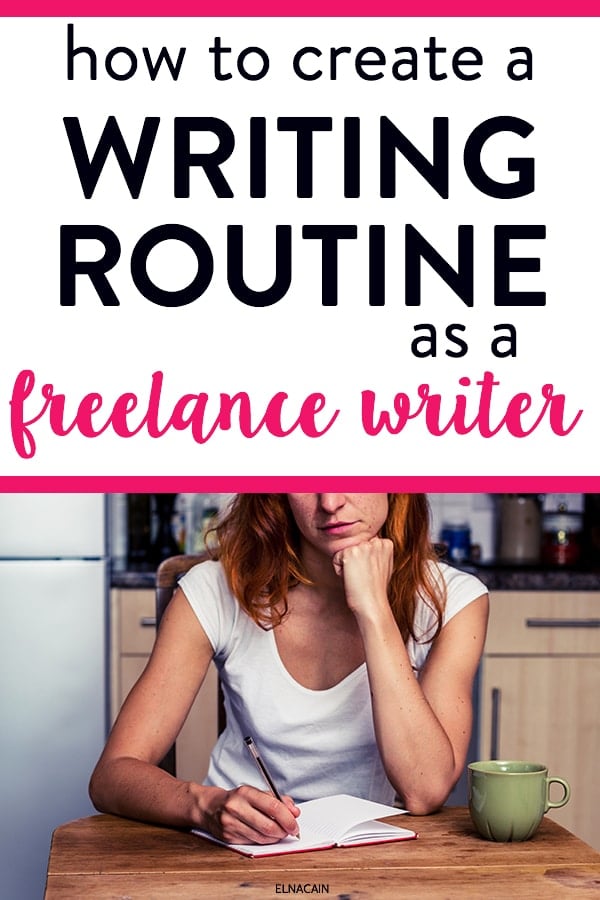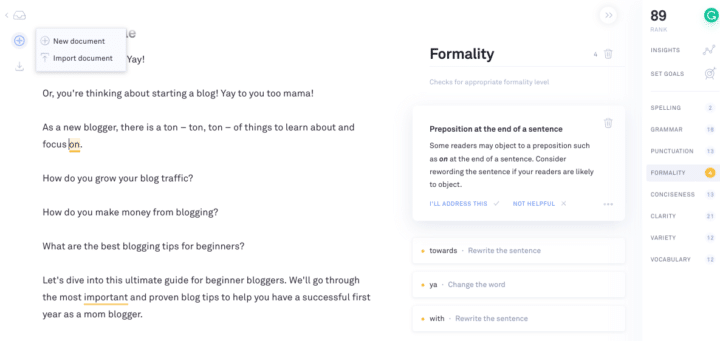It’s time to write.
You’re a freelance writer, and this is your job.
But, life gets in the way – appointments, family, your other job and chores.

How do you fit a writing routine into your day as a freelance writer?
I’ve been freelance writing for a few years now – with twins – and I’ve developed a pitching process, writing process and now a writing routine so that I can maximize the time I have.
If you’re thinking about becoming a freelance writer, you’ll need some writing routine ideas and tips so that you have time to write for your clients and you can pick up more freelance writing jobs.
But, first, let’s understand why you need a routine for your writing.
Why You Need a Writing Routine

I don’t know about you, but before I became a freelance writer, I wasn’t really a writer.
I didn’t have a journalism degree, and I didn’t write a book in my spare time either.
In high school, I wrote a lot of poetry, and I enjoyed writing term papers in college. I learned over the years that writing was my creative outlet and passion. I expressed myself much better through writing than with talking.
But, I didn’t improve my skill as a writer at that time.
The ONLY time I was able to improve my writing was when I became a freelance writer and blogger!
Do you see the connection?
When you write every day, you improve your writing. This is exercise for your mind. As a freelance writer, you need to flex those writing muscles and be able to transfer your skills to different niches in the beginning.
Let me share something with you –
When you first start out as a freelance writer, you may pick up gigs that aren’t in your intended niche. This may be because you haven’t decided on a niche yet or you pitched to a variety of freelance writing jobs and the gig with a topic outside your niche decided to hire you.
That’s ok.
When I first started I wrote on a ton of different topics:
- Internet of Things
- Automotive industry
- Dentistry
- Working at home
- Productivity
- Health and food
- Virtual Effects industry
I certainly wasn’t credible in those niche topics, and I had no experience writing in those topics. But, as a freelance writer, you may have to transfer your skills as a general writer to a new niche.
That’s why it’s important to develop not only a writing process but a routine so that you can write up these projects quickly and efficiently.
Phases of Writing Process for Your Freelance Writing Job
To begin a writing routine when you work at home, you need to look at the phases of your writing. For a client piece, you want to provide a full piece. This means having all the proper formatting and features in your article.
You also want to have a project management system in place for all your client pieces. You definitely don’t want to miss any deadlines!
Let’s go through the writing process you should incorporate when you have to write something for your freelance writing client.
1. Idea Generation
For some clients, you will have to come up with the ideas for a blog post or article. This is especially true when you start building your portfolio through guest posting. It’s up to you to come up with relevant blog post topics for guest posts, your own blog and client pieces.
So, how do you do this consistently and on a regular basis?
Check out my video for tips to help create blog topics for your clients.
Some popular places to get ideas are:
- Other blogs
For example, if your client is in the productivity niche for entrepreneurs, then you can think about ideas around that topic. For example, structuring your day or making sure you are mentally healthy are ideas that I can look on Google to see if it’s a viable topic (i.e. are other blogs talking about this topic or am I just way off?)

As you can see, mental health is a HUGE topic on BIG sites like newspapers and Forbes.
The idea is to look at the niche you are writing in and plug that in Pinterest or Google to get ideas. From there pick a subtopic and research that further.
2. Create an Outline
Once you have decided on a blog topic for your freelance writing job, it’s time to create an outline.
Some clients request an outline before you write the post. For me, I sometimes provide an outline to a client (even if they don’t ask for it) as a way to assure if what I’m writing is on the right track for the client. It’s like a heads up for them!
When creating an outline, you want to walk the reader through your post in a coherent way. What are the main subtopics of your topic?
If we go back to our topic of mental health and entrepreneurs, I can look at the top posts from Google to see what others are writing about and incorporate that into my outline. I wouldn’t copy the exact subheadings from a blog post, but I would look at several and generate my own ideas about the topic.
3. Write the Rough Draft
Many writers tell you to just write the rough draft without hitting the backspace button. But, for me that’s impossible. I can’t live seeing grammar errors or spelling mistakes. So I will fix those as I write my rough draft and then when I’m done, I walk away.
I take a five-minute break or have lunch and then go back to my piece to re-read the full draft.
You NEED to take that break for your piece to breathe, but more importantly, for you to disengage from your piece and switch your mind from it. You’ll have a fresh pair of eyes when doing this.

4. Edit Your Post
In the editing process, you may re-write certain sentences or phrases or add additional information to your piece.
This is when I may decide to include another case study or pick a subtopic and break it down even more.
This is a crucial component to your freelance writing client’s project because they are looking to you to be the expert in writing. It’s up to you to format the post appropriately, have a hook for their readers to want to read more and provide relevant and up-to-date information in your chosen niche topic.
5. Final Edit
The final edit may incorporate an editing tool like Grammarly. I always run my content for my clients or for my own blogs through Grammarly. It’s super easy to use and I use the desktop version.
Grammarly gives you a score and breaks down grammar errors like spelling, clarity, vocabulary and more.
I don’t always use the suggestions Grammarly gives me as I want to inject my personality and my writing quirks, but I do rely on it for fixing most of my grammar errors.
6. Have a Proofreader
This is optional, but it’s a good idea to get a second pair of eyes to read through your final edited piece.
There will be errors you did not notice (or that Grammarly or whatever editing app you decide to use did not either) that your proofreader will.
My husband has graciously been my proofreader for years. I also hired a copyeditor when I had a lot of projects in the digital marketing niche. This was a lifesaver for sure, but it came with an expense.
If you are budgeting your freelance writing business, consider a family member or even another freelance writer.
Email a new writer and swap pieces! Help each other out!
7. Submission
This is the final step! It’s time to submit your piece. There are several ways you can submit your piece to your client, so make sure you ask them the best way to submit your piece. Some clients want you to use Google Docs and share your piece with them.
Other’s don’t mind if you email it to them.
My post on FreelancerFAQs gives you a breakdown of many ways to submit your piece!
Writing Routine Ideas
With the writing process out of the way, you need a routine that encompasses this process. In this list, find what works for you.
1. Brain Dump for Content Ideas
For many people, a brain dump is the perfect writing routine! Get a notebook, bullet journal or use Trello to keep track of your content ideas as you brain dump.
You can also create a swipe file (folder on your desk or a Google Sheet or Doc) with blog posts you enjoyed, lead magnets you found helpful and any content you see online. This can help spur more blog post ideas or content ideas for your freelance client.
2. Write Every Day
Do what I do and commit to writing every day. This can help you discover your unique writing style. It is also helpful to keep your skills up to par! You don’t have to write 1,000-word blog posts every day; instead, try writing:
- A Facebook post
- A Tweet on Twitter
- An email
- Your updated LinkedIn profile
- A freelance writing pitch
- A guest post
- A blog post
- A blog comment
- Your to-do list in your bullet journal
- Blog post headlines
- Pinterest pin description
- Introduction to a post
The list is endless. The point is to write every day. Now that my twins are in school, I have more time to write. I’m working on writing a blog post every day whether it’s for for a client or for me.
This also helps me improve my typing speed. I’m able to write over a thousand words in about an hour and take 20 minutes to proofread and create graphics to share on social media. It’s part of my work day, and the more I do this, the faster I become!
3. Carve Out Time

The easiest thing to start your writing routine is to find time to write! Carve out dedicated time to write…every day! This may mean writing after work, writing only on Sunday afternoons, or writing before you go to work in the morning.
Find what works for you! When I first started, I only could write during nap times or when my twins went to sleep for the night. Writing while they were awake or before they woke up was not good!
4. Find the Best Time to Write
This goes hand-in-hand to carving out that time. Figure out your most optimal time to write. Since early morning for me was a gong show, I knew that I could write at night.
But, now, that has changed. Over the years raising twins, I’m pretty exhausted at night, so now I do my writing mid-morning. I consider it a success when I finish before lunch!
5. Train Your Mind for Work
This is important. You don’t want to squander your time with distractions on social media or phone calls.
For me, I need music to switch my brain from mom mode to writer mode.
I also have to have a workspace to make the transition easier for me. I have a work office, and I do all of my work here.
Having these external prompts can help you train your mind. Once it hears the music you use for work, your brain will switch automatically!
6. Create a Working Outline of Your Content
During the writing process, you create an outline, but sometimes that process may not benefit you or your writing style.
Sometimes you just need a working outline. This means you have several projects on the go and you work on it every day.
For many freelance writers, this is how they work. They may have 3 or 4 personal blog posts half written and 2 or 3 client pieces that aren’t finished yet. Personally, I do a bit of both.
For my personal blogs, I do have several posts that are half-written or has a…working outline!
For example, this post I’m writing had a working outline for months. I’m now getting to it and writing it for you!
7. Time Your Writing
This can be a HUGE push and motivator for some people. Set a timer and time your writing. See how fast you write and work on improving that over time. This can set your writing routine off on a bang and you can boost your productivity quickly by doing this!
There Ya Go!
I hope this post will help you when you get your first writing gig and need to submit your first piece to your client! A writing routine for a writer is important for sure!
This become a writing habit for sure and will set your day for success!
Tell me in the comments your favorite way to find content ideas for your clients!






16 Comments